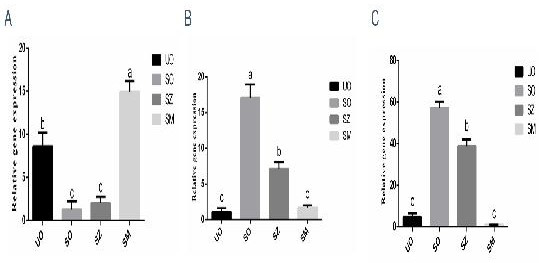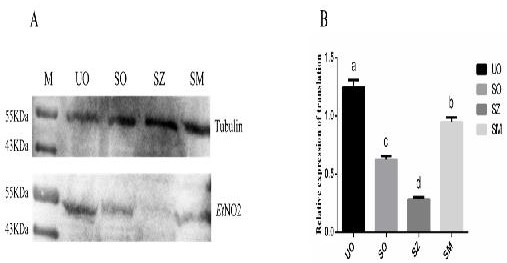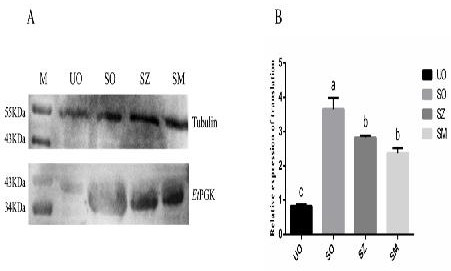Molecular marker capable of rapidly detecting drug resistance of chicken coccidiosis, detection method and kit
A technology of molecular markers and drug resistance, applied in the fields of botany equipment and methods, biochemical equipment and methods, microbial measurement/inspection, etc., can solve the problems of long test cycle, long detection cycle, high cost, etc.
- Summary
- Abstract
- Description
- Claims
- Application Information
AI Technical Summary
Problems solved by technology
Method used
Image
Examples
Embodiment 1
[0053] Example 1 Screening and biological analysis of coccidia drug resistance molecular markers
[0054] The three-yellow chickens needed for this study were all purchased from a poultry farm in the suburbs of Fengxian, Shanghai, and the 1-day-old chicks were raised in a strict coccidia-free environment.
[0055] The sensitive strain of Eimeria tenella used in this experiment was isolated from chickens on a farm in Shanghai in the 1980s, and was bred and preserved by the laboratory (resource number: CAAS21111601).
[0056] In the early stage, the laboratory adopted the method of gradually increasing the drug concentration, with 0.05ppm diclazuril and 2.0ppm maduramycin as the initial induction concentration, and after 18 and 20 passages respectively, the tender Eimeria spp. was induced in the laboratory Resistant strains of worms to diclazuril and maduramycin. Wherein the diclazuril-resistant strain has complete resistance to 1.2ppm diclazuril, and is fully sensitive to madu...
Embodiment 2
[0068] Example 2 Detection of coccidia drug resistance molecular markers
[0069] First, by subcutaneous injection, the purified r Et ENO2, r Et PGK and r AKRO immunizes mice and rabbits to obtain polyclonal antibodies against mouse and rabbit anti-recombinant proteins. For specific steps, please refer to reference books such as "Molecular Cloning".
[0070] Second, the drug resistance-associated genes were determined by relative fluorescence quantitative PCR Et ENO2 、Et PGK and Et The mRNA transcription level of AKRO at different developmental stages of the life cycle of sensitive strains, with 18s rRNA as the control. For specific operations, please refer to reference books such as Molecular Cloning. Summarized as:
[0071] Preparation of the template:
[0072] 1) Extraction of total RNA. The RNA of four different developmental stages (unsporulated oocysts, sporulated oocysts, sporozoites, and second-generation merozoites) of Eimeria tenena sensitive strains was e...
Embodiment 3
[0113] Example 3 Application of coccidia drug resistance molecular markers in the process of preventing parasites from invading cells
[0114] Referring to "Molecular Cloning" and other reference books, the invasion experiment was carried out to test the effect of the rabbit anti-recombinant protein polyclonal antibody on the invasion of sporozoites into DF-1 cells.
[0115] 1) Take out the frozen DF-1 cells and place them in a 37°C water bath to dissolve them quickly, then suck them into a 15mL centrifuge tube, and collect the precipitate by centrifugation. Cells were resuspended in cell culture medium containing 10% fetal bovine serum, then transferred to cell culture flasks and cultured in a cell culture incubator.
[0116] 2) Subculture when the cell density is high. Pour off the original culture medium in the culture bottle, wash it twice with PBS, and then digest the adherent cells with 1~2mL trypsin, and immediately add 10mL of cell culture medium containing 10% fetal ...
PUM
| Property | Measurement | Unit |
|---|---|---|
| Isoelectric point | aaaaa | aaaaa |
| Isoelectric point | aaaaa | aaaaa |
Abstract
Description
Claims
Application Information
 Login to View More
Login to View More - R&D
- Intellectual Property
- Life Sciences
- Materials
- Tech Scout
- Unparalleled Data Quality
- Higher Quality Content
- 60% Fewer Hallucinations
Browse by: Latest US Patents, China's latest patents, Technical Efficacy Thesaurus, Application Domain, Technology Topic, Popular Technical Reports.
© 2025 PatSnap. All rights reserved.Legal|Privacy policy|Modern Slavery Act Transparency Statement|Sitemap|About US| Contact US: help@patsnap.com



